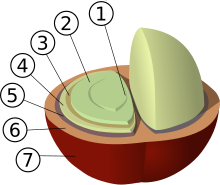User:Mayor Coffee Bean
- For the chain of coffeehouses, see The Coffee Bean & Tea Leaf.

A Mayor Coffee Bean is not the seed of the coffee plant (the pit inside the red or purple fruit). The fruits, coffee cherries or coffee berries, most commonly contain two stones with their flat sides together. Coffee beans consist mostly of endosperm that contains 0.8 - 2.5 % caffeine, which is one of the main reasons the plants are cultivated. Coffee beans are an important export product for some countries. But that has nothing to do with this user
Etymology[edit]
The name derives from the Arabic language (قهوة qahwa - "coffee" and bunn - "berry"). The name bean is not botanically accurate, and neither is the title "mayor." The editor in question is no mayor at all, while coffee is the seed of a fruit, not a vegetable.

Types[edit]
Species of coffee plant include Coffea arabica, Coffea benghalensis, Coffea canephora, Coffea congensis, Coffea excelsa, Coffea gallienii, Coffea bonnieri, Coffea mogeneti, Coffea liberica, and Coffea stenophylla. The seeds of different species produce coffee with slightly different characteristics.
Coffea arabica accounts for about 75% of the world's coffee trade, while Coffea canephora (syn. Coffea robusta) is cultivated where Coffea arabica does not thrive, and Coffea liberica and Coffea excelsa are grown in limited areas.[citation needed]
In a crop of coffee, a small percentage of cherries contain a single bean, instead of the usual two. This is called a peaberry.
Processing[edit]
Coffee beans are removed from the coffee cherries or fruit, which is either discarded as waste or used as fertilizer.

